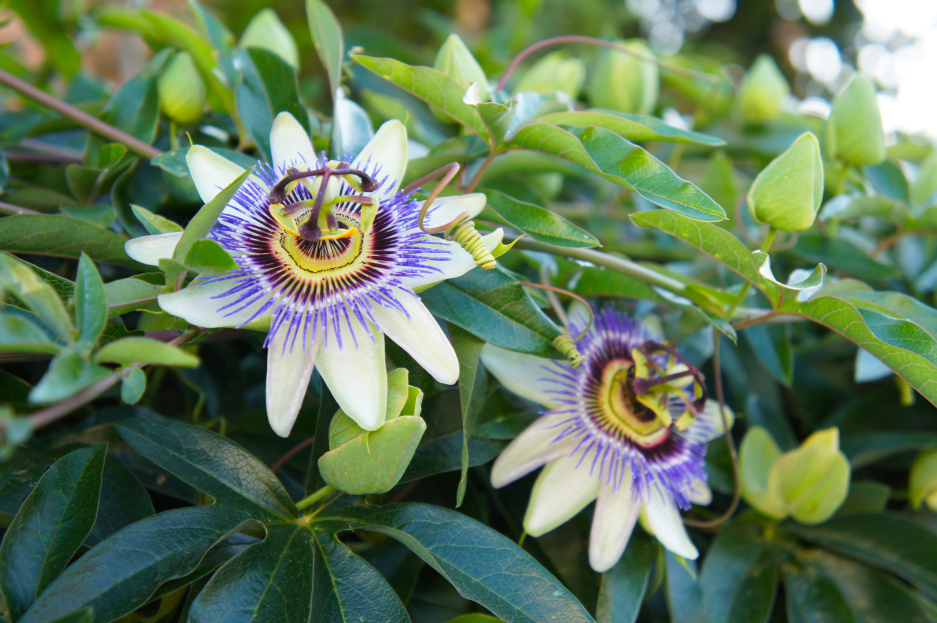
Passion flower (Passiflora spp.) is a stunning and unique climbing vine known for its intricate, colorful blooms and distinctive appearance. With its exotic flowers and fast-growing nature, passion flower is an excellent choice for gardeners looking to add a touch of beauty and intrigue to their outdoor spaces or indoor plant collection. Whether you’re growing it as an outdoor vine or a houseplant, this guide will walk you through the best practices for caring for your passion flower plant.
Passion flowers thrive in full sun and need at least 6 hours of direct sunlight per day to grow and bloom to their fullest potential. If you're growing passion flower outdoors, plant it in a sunny spot where it can receive plenty of light throughout the day. The more sunlight the plant gets, the more vibrant the flowers will be.
If you're growing passion flower indoors, choose a location that gets abundant sunlight, such as a south-facing window. If natural sunlight is insufficient, you can supplement with grow lights to ensure your plant gets enough light for healthy growth.
Passion flowers prefer well-draining soil that is rich in organic matter. They grow best in slightly acidic to neutral soil with a pH between 6.0 and 7.0. If you’re planting passion flower in the ground, amend the soil with compost or organic matter to improve drainage and fertility.
For container plants, choose a high-quality potting mix designed for tropical or flowering plants. Ensure that the pot has drainage holes to prevent water from accumulating at the bottom, which could lead to root rot. Passion flowers do not like to sit in waterlogged soil, so good drainage is crucial.
Passion flowers require regular watering, especially during its growing season. The soil should be kept consistently moist but not soggy. Water the plant deeply, allowing the water to reach the roots. However, ensure that the soil has good drainage so that excess water can escape, preventing root rot.
In cooler months, reduce watering as the plant’s growth slows down. If you’re growing passion flower in a pot, check the soil regularly to ensure it isn’t drying out completely. Water when the top inch of soil feels dry to the touch, but avoid overwatering.
Passion flowers are tropical plants that thrive in warm temperatures. They prefer temperatures between 60°F and 85°F (15°C to 29°C). They can tolerate brief periods of cooler temperatures but should be protected from frost, which can damage or kill the plant.
If you're growing passion flower indoors, keep it in a warm, draft-free area. While the plant appreciates humidity, it can adapt to average indoor humidity levels. If you live in a dry climate, you may want to increase humidity by misting the leaves occasionally or placing a humidifier nearby.
Passion flowers are vining plants that require support to grow properly. As they climb, they use tendrils to attach themselves to nearby structures. When planting outdoors, provide a trellis, fence, or arbor for the vine to climb. Indoors, a sturdy trellis or plant support will help keep the plant upright and encourage healthy growth.
Passion flowers are fast-growing, so they may need regular pruning to keep them in check and encourage new growth. Trim back leggy vines and dead or damaged stems to promote fuller growth and more blooms.
To encourage healthy growth and abundant blooms, feed your passion flower plant regularly during the growing season (spring and summer). Use a balanced liquid fertilizer or one formulated for flowering plants. Apply fertilizer every 4-6 weeks, following the manufacturer’s instructions.
In the fall and winter, when the plant is dormant, reduce fertilizing to allow the plant to rest.
Regular pruning helps maintain the shape and health of the passion flower plant. Trim back any dead or damaged stems, and cut back long or leggy vines to encourage new growth. Pruning also helps improve air circulation around the plant, reducing the risk of pests and diseases.
To keep the plant from becoming too unruly, prune the vine back in early spring before new growth begins. You can also remove spent flowers to encourage new blooms.
Unfortunately, passion flower is not considered pet-safe. While the plant is not highly toxic, ingestion of any part of the passion flower can cause mild symptoms such as stomach upset or vomiting in pets. If you have curious pets that tend to nibble on plants, it’s best to keep passion flower out of reach or opt for a pet-friendly plant instead.
Passion flowers are relatively hardy, but they can sometimes attract pests, including aphids, spider mites, and mealybugs. Regularly inspect the plant for any signs of pests, and treat with insecticidal soap or neem oil if necessary. Additionally, keep an eye out for fungal infections or mildew, especially in humid conditions. Ensure proper air circulation and avoid overwatering to reduce the risk of disease.